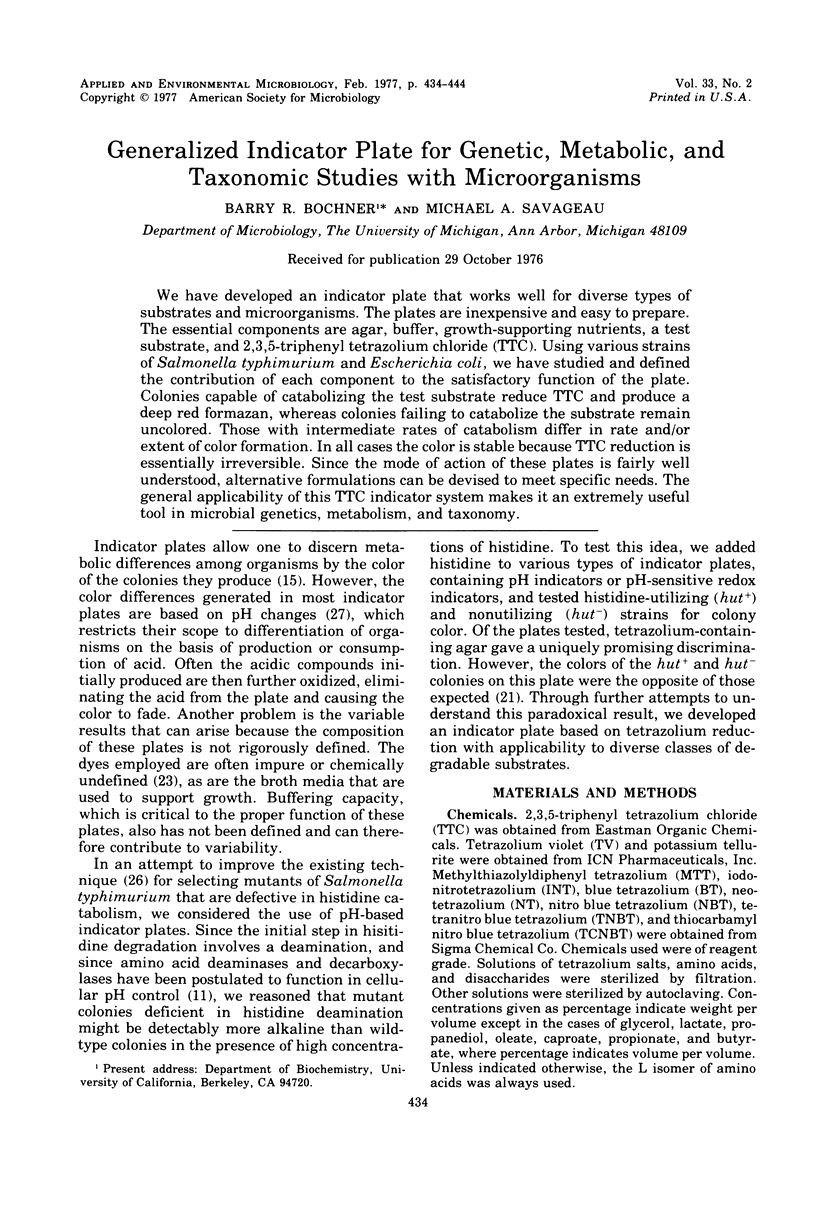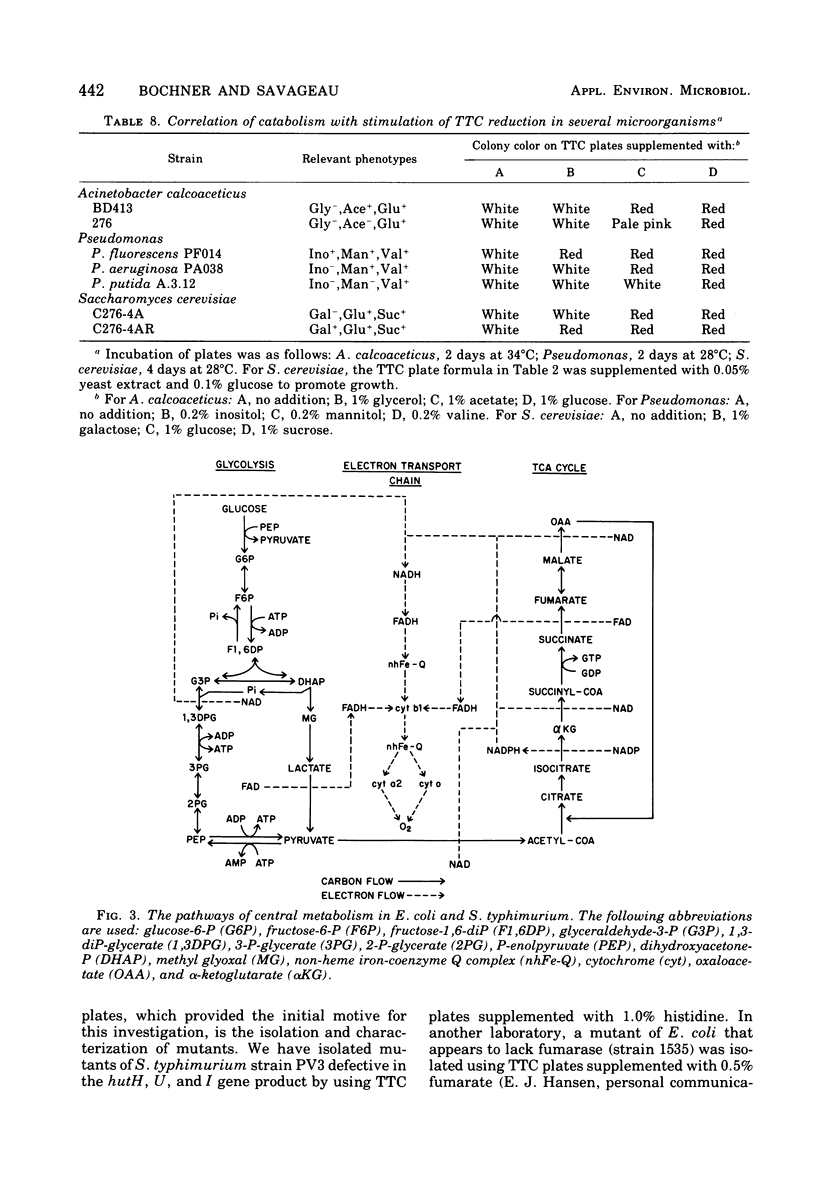Abstract
We have developed an indicator plate that works well for diverse types of substrates and microorganisms. The plates are inexpensive and easy to prepare. The essential components are agar, buffer, growth-supporting nutrients, a test substrate, and 2,3,5-triphenyl tetrazolium chloride (TTC). Using various strains of Salmonella typhimurium and Escherichia coli, we have studied and defined the contribution of each component to the satisfactory function of the plate. Colonies capable of catabolizing the test substrate reduce TTC and produce a deep red formazan, whereas colonies failing to catabolize the substrate remain uncoloured. Those with intermediate rates of catabolism differ in rate and/or extent of color formation. In all cases the color is stable because TTC reduction is essentially irreversible. Since the mode of action of these plates is fairly well understood, alternative formulations can be devised to meet specific needs. The general applicability of this TTC indicator system makes it an extremely useful tool in microbial genetics, metabolism, and taxonomy.
Full text
PDF










Images in this article
Selected References
These references are in PubMed. This may not be the complete list of references from this article.
- Alper M. D., Ames B. N. Positive selection of mutants with deletions of the gal-chl region of the Salmonella chromosome as a screening procedure for mutagens that cause deletions. J Bacteriol. 1975 Jan;121(1):259–266. doi: 10.1128/jb.121.1.259-266.1975. [DOI] [PMC free article] [PubMed] [Google Scholar]
- Altman F. P., Butcher R. G. Studies on the reduction of tetrazolium salts. I. The isolation and characterisation of a half-formazan intermediate produced during the reduction of neotetrazolium chloride. Histochemie. 1973 Dec 31;37(4):333–350. doi: 10.1007/BF00274969. [DOI] [PubMed] [Google Scholar]
- Cox G. B., Gibson F. Studies on electron transport and energy-linked reactions using mutants of Escherichia coli. Biochim Biophys Acta. 1974 Apr 30;346(1):1–25. doi: 10.1016/0304-4173(74)90010-x. [DOI] [PubMed] [Google Scholar]
- Cronan J. E., Jr, Nunn W. D., Batchelor J. G. Studies on the biosynthesis of cyclopropane fatty acids in Escherichia coli. Biochim Biophys Acta. 1974 Apr 26;348(1):63–75. doi: 10.1016/0005-2760(74)90093-9. [DOI] [PubMed] [Google Scholar]
- Dendinger S., Brill W. J. Regulation of proline degradation in Salmonella typhimurium. J Bacteriol. 1970 Jul;103(1):144–152. doi: 10.1128/jb.103.1.144-152.1970. [DOI] [PMC free article] [PubMed] [Google Scholar]
- EIDUS L., DIENA B. B., GREENBERG L. Observations on the use of tetrazolium salts in the vital staining of bacteria. Can J Microbiol. 1959 Jun;5(3):245–250. doi: 10.1139/m59-028. [DOI] [PubMed] [Google Scholar]
- Forrest W. W., Walker D. J. The generation and utilization of energy during growth. Adv Microb Physiol. 1971;5:213–274. doi: 10.1016/s0065-2911(08)60408-7. [DOI] [PubMed] [Google Scholar]
- Gale E. F., Epps H. M. The effect of the pH of the medium during growth on the enzymic activities of bacteria (Escherichia coli and Micrococcus lysodeikticus) and the biological significance of the changes produced. Biochem J. 1942 Sep;36(7-9):600–618. doi: 10.1042/bj0360600. [DOI] [PMC free article] [PubMed] [Google Scholar]
- Gutnick D., Calvo J. M., Klopotowski T., Ames B. N. Compounds which serve as the sole source of carbon or nitrogen for Salmonella typhimurium LT-2. J Bacteriol. 1969 Oct;100(1):215–219. doi: 10.1128/jb.100.1.215-219.1969. [DOI] [PMC free article] [PubMed] [Google Scholar]
- Hansen E. J., Juni E. Two routes for synthesis of phosphoenolpyruvate from C4-dicarboxylic acids in Escherichia coli. Biochem Biophys Res Commun. 1974 Aug 19;59(4):1204–1210. doi: 10.1016/0006-291x(74)90442-2. [DOI] [PubMed] [Google Scholar]
- Hartman P. E. Some improved methods in P22 transduction. Genetics. 1974 Apr;76(4):625–631. doi: 10.1093/genetics/76.4.625. [DOI] [PMC free article] [PubMed] [Google Scholar]
- Holms W. H., Bennett P. M. Regulation of isocitrate dehydrogenase activity in Escherichia coli on adaptation to acetate. J Gen Microbiol. 1971 Jan;65(1):57–68. doi: 10.1099/00221287-65-1-57. [DOI] [PubMed] [Google Scholar]
- Juni E. Interspecies transformation of Acinetobacter: genetic evidence for a ubiquitous genus. J Bacteriol. 1972 Nov;112(2):917–931. doi: 10.1128/jb.112.2.917-931.1972. [DOI] [PMC free article] [PubMed] [Google Scholar]
- Kahane S., Marcus M., Barash H., Halpern Y. S. Sodium-dependent glutamate transport in membrane vesicles of Escherichia coli K-12. FEBS Lett. 1975 Aug 15;56(2):235–239. doi: 10.1016/0014-5793(75)81099-4. [DOI] [PubMed] [Google Scholar]
- Kushnarev V. M. Obrazovanie nerastvorimykh produktov v kletkakh gram-otritsatel'nykh bakterii i ikh vydelenie. Dokl Akad Nauk SSSR. 1966 Nov 1;171(1):207–208. [PubMed] [Google Scholar]
- Lakshmi T. M., Helling R. B. Selection for citrate synthase deficiency in icd mutants of Escherichia coli. J Bacteriol. 1976 Jul;127(1):76–83. doi: 10.1128/jb.127.1.76-83.1976. [DOI] [PMC free article] [PubMed] [Google Scholar]
- Lederberg J. Detection of Fermentative Variants with Tetrazolium. J Bacteriol. 1948 Nov;56(5):695–695. doi: 10.1128/jb.56.5.695-695.1948. [DOI] [PMC free article] [PubMed] [Google Scholar]
- Leene W., van Iterson W. Tetranitro--blue tetrazolium reduction in Bacillus subtilis. J Cell Biol. 1965 Oct;27(1):237–241. doi: 10.1083/jcb.27.1.237. [DOI] [PMC free article] [PubMed] [Google Scholar]
- MCFALL E. GENETIC STRUCTURE OF THE D-SERINE DEAMINASE SYSTEM OF ESCHERICHIA COLI. J Mol Biol. 1964 Sep;9:746–753. doi: 10.1016/s0022-2836(64)80179-0. [DOI] [PubMed] [Google Scholar]
- Malatian M. N., Biriuozova V. I. O lokalizatsii degidrogenaznoi aktivnosti v analogakh mitokhnodrii bakterial'nykh kletok. Dokl Akad Nauk SSSR. 1965 Feb 11;160(5):1182–1184. [PubMed] [Google Scholar]
- Meiss H. K., Brill W. J., Magasanik B. Genetic control of histidine degradation in Salmonella typhimurium, strain LT-2. J Biol Chem. 1969 Oct 10;244(19):5382–5391. [PubMed] [Google Scholar]
- NAGAI S., YANAGISHIMA N., NAGAI H. Advances in the study of respiration-deficient (RD) mutation in yeast and other microorganisms. Bacteriol Rev. 1961 Dec;25:404–426. doi: 10.1128/br.25.4.404-426.1961. [DOI] [PMC free article] [PubMed] [Google Scholar]
- Olsen R. H., Metcalf E. S., Todd J. K. Characteristics of bacteriophages attacking psychrophilic and mesophilic pseudomonads. J Virol. 1968 Apr;2(4):357–364. doi: 10.1128/jvi.2.4.357-364.1968. [DOI] [PMC free article] [PubMed] [Google Scholar]
- Pegram R. G. The microbiological uses of 2, 3, 5-triphenyltetrazolium chloride. J Med Lab Technol. 1969 Jul;26(3):175–198. [PubMed] [Google Scholar]
- Pegram R. G. The microbiological uses of 2,3,5,--triphenyltetrazolium chloride: an addendum. Lab Pract. 1972 May;21(5):340–341. [PubMed] [Google Scholar]
- SMITH F. E. Tetrazolium salt. Science. 1951 Jun 29;113(2948):751–754. doi: 10.1126/science.113.2948.751-a. [DOI] [PubMed] [Google Scholar]
- Smith H. O., Levine M. A phage P22 gene controlling integration of prophage. Virology. 1967 Feb;31(2):207–216. doi: 10.1016/0042-6822(67)90164-x. [DOI] [PubMed] [Google Scholar]
- Sridhara S., Wu T. T., Chused T. M., Lin E. C. Ferrous-activated nicotinamide adenine dinucleotide-linked dehydrogenase from a mutant of Escherichia coli capable of growth on 1, 2-propanediol. J Bacteriol. 1969 Apr;98(1):87–95. doi: 10.1128/jb.98.1.87-95.1969. [DOI] [PMC free article] [PubMed] [Google Scholar]
- Stanisich V., Holloway B. W. Conjugation in Pseudomonas aeruginosa. Genetics. 1969 Feb;61(2):327–339. doi: 10.1093/genetics/61.2.327. [DOI] [PMC free article] [PubMed] [Google Scholar]
- VANDERWINKEL E., MURRAY R. G. [Bacterial intracytoplasmic organelles and the site of oxidation-reduction activity]. J Ultrastruct Res. 1962 Aug;7:185–199. doi: 10.1016/s0022-5320(62)80035-5. [DOI] [PubMed] [Google Scholar]
- WEINBERG E. D. Selective inhibition of microbial growth by the incorporation of triphenyl tetrazolium chloride in culture media. J Bacteriol. 1953 Aug;66(2):240–242. doi: 10.1128/jb.66.2.240-242.1953. [DOI] [PMC free article] [PubMed] [Google Scholar]
- Wilkinson L. E., Pringle J. R. Transient G1 arrest of S. cerevisiae cells of mating type alpha by a factor produced by cells of mating type a. Exp Cell Res. 1974 Nov;89(1):175–187. doi: 10.1016/0014-4827(74)90200-6. [DOI] [PubMed] [Google Scholar]
- Young I. G. Biosynthesis of bacterial menaquinones. Menaquinone mutants of Escherichia coli. Biochemistry. 1975 Jan 28;14(2):399–406. doi: 10.1021/bi00673a029. [DOI] [PubMed] [Google Scholar]



